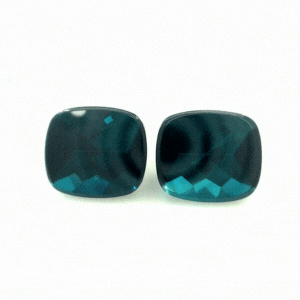
Table of Contents
Tourmaline, the most colorful mineral and gemstone on earth, is also the birthstone for October. It’s very easy to find in many jewelry stores because of its popularity brought about by its dazzling colors. In this article, get to know more about this multi-colored beauty as we dig deep into the truth and tales that surround it.

What is Tourmaline?
Tourmaline is a borosilicate mineral mixed with elements like aluminum, iron, lithium, magnesium, potassium, or sodium. Different chemical compositions allow tourmaline to exist in a wide range of colors. For instance, traces of lithium and iron produce green tourmalines and red and green for those with manganese compositions. Radiation and other laboratory procedures can also affect the colors.
The name tourmaline comes from the Sinhalese “tourmali” which means mixed stone.
How does tourmaline form?
Most tourmalines are found in pegmatites.
Pegmatites are an intrusive igneous rock that contains large crystals with minerals not commonly found in other rocks. To be a pegmatite, the rock should contain a crystal not smaller than one centimeter in diameter.
Tourmaline forms in these igneous rocks during hydrothermal activity. When the liquid cools, the minerals crystalize and form tourmaline crystals. Some tourmaline varieties can also grow in metamorphic rocks.
Where to find tourmalines?
Brazil is the top source of tourmaline, which started nearly 500 years ago. However, back then Portuguese explorers mistook blue and green tourmalines for sapphire and emeralds until 1793 when this colorful gem became a recognized distinct mineral.
The USA, particularly Paris, Maine, was also a tourmaline-producing location. This started in 1821 when tourmaline was discovered in the area. Maine was known for its pink tourmalines but California has mined red tourmalines since the 1800s.
Madagascar, Mozambique, Malawi, Namibia, Nigeria, Pakistan, and Tanzania are also tourmaline-producing countries.
Tourmaline Species and Color Varieties
There are mainly 4 species of tourmaline.
1. Elbaite
Most multicolored tourmalines are elbaite, covering every color in the spectrum.
Elbaite is unsurpassed in beauty because of its interesting optical properties. It’s pleochroic which means the gem exhibits different colors when you view it in light polarized in different directions.
2. Dravite
Dravite is a magnesium-rich tourmaline; hence, its colors mostly range from pale brown to dark brown and brownish-black. However, deep green and dark yellow can also qualify as a dravite.
3. Liddicoatite
Previously thought of as an Elbaite, Liddicoatite looks similar to Elbaite because of its almost identical chemical composition. The difference, however, still lies in its chemical formula where a calcium atom replaces a sodium atom.
Liddicoatite can be pink, red, green, blue, or smoky brown.
4. Schorl
Schorl is the most common tourmaline species and is definitely one of the most aesthetic black gemstones. This type of tourmaline is never transparent or translucent but it can be intergrown with elbaite.
These four species can be grouped into many different colors, as you can see below.
- Achroite – colorless tourmaline
- Bi-color – two-colored tourmaline

- Indicolite – blue tourmaline

- Paraiba – neon-colored elbaite tourmaline

- Rubellite – red tourmalines

- Siberite – Reddish-violet tourmaline
- Tri-color – three-colored tourmaline
- Verdelite – green tourmaline

- Watermelon – This tourmaline has a pink core with green edges, resembling the fruit.

Meanings, Symbols, and Properties
Tourmaline, the birthstone for October, is known to be a stone of reconciliation and compassion. It radiates healing energy and inspires creativity; thus, making it popular among artists and poets. The meaning of this gem may vary based on color.
For instance, red enhances inner strength and wisdom while blue brings tranquility and peace.
Further, the colors also entail different protective energies. If you believe in healing crystals, you may carry black tourmaline to protect you from negative energy. The pink variety is very feminine. It is associated with love, friendship, and compassion for humanity.
The green tourmaline provides healing energy to the body and represents vitality and growth while the brown ones stand for transformation.
Quality Factors
Like other gemstones, you can assess the quality of a tourmaline based on color, clarity, cut, and carat weight.
Color
With its wide variety of colors, you will likely find a customer for each color. However, pink and red varieties are among the most sought-after. Meanwhile, the green variety is the most valuable because of its strong pleochroic effect.
Paraiba’s electrifying color, on the other hand, did not escape the attention of gem enthusiasts. This and its rarity have made it a high-priced tourmaline.
Clarity
Because of the environment in which they are formed, inclusions are a part of tourmaline. The more visible the inclusions are, the more the value of this gem drops; however, it could be a different story if the gem has a redeeming quality. For instance, dealers and other gem enthusiasts would tolerate a red tourmaline with visible inclusions as long as the color saturation is strong.
Inclusions that appear like long hollow tubes when cut correctly can produce a cat’s eye effect as shown in the 360-degree video below.

Cut
It’s common to find tourmalines in rectangular cuts to reduce waste and consider optical properties. For example, since tourmaline is pleochroic, a pink tourmaline can be very dark when you look down its length.

Carat Weight
The per-carat price of fashioned tourmalines increases as they increase in size. Further, the price of facet-quality rough gems increases as the supply decreases.
Taking photos and 360 videos of tourmaline
Are you curious about how we take photos and 360 videos of our tourmalines? Click and watch the video below and see how we did it all in just one click using the GemLightbox and a smartphone.
Together with opal, tourmaline is the birthstone for October. Take your tourmalines out of your inventory. It’s time to delight the October babies on your customer list!



0 Comments